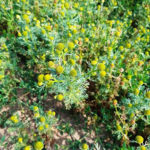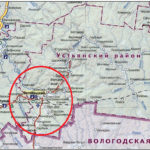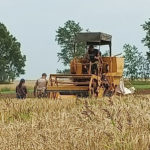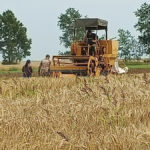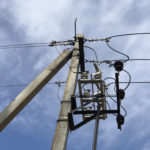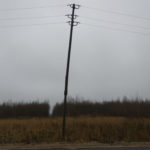ALIEN SPECIES OF VASCULAR PLANTS IN PLANT COMMUNITIES OF THE MIDDLE TAIGA OF THE ARKHANGELSK REGION
Chmykhov А.А. , Leonova N.B. ALIEN SPECIES OF VASCULAR PLANTS IN PLANT COMMUNITIES OF THE MIDDLE TAIGA OF THE ARKHANGELSK REGION // Ecosystems: ecology and dynamics. No 3. 2023. P. 28-48. | Abstract | PDF | Reference
- The study area on the contemporary map of the Arkhangelsk Region
- Pine forest in the valley of the Kokshenga River (photo by A.A. Chmykhov)
- Lupinus pollyphyllus (photo by A.A. Chmykhov)
- Heracleum sosnowskyi (photo by A.A. Chmykhov)
- Overgrowing fallow land (photo by A.A. Chmykhov)
- Lupinus pollyphyllus in a clearing (photo by A.A. Chmykhov)
- Abandoned village (photo by M.B. Stevanovich)
- Matricaria discoidea DC on a field road (photo by A.A. Chmykhov)
In this article we discuss the distribution of alien species in the vegetation cover of the middle taiga of the Arkhangelsk Region. This is a relevant problem that has not been studied so far. We used the data of long-term biogeographic studies obtained from the Ustyanskaya Educational and Research Station located in the Arkhangelsk Region, M.V. Lomonosov Moscow State University, Faculty of Geography; as well as our own field materials for 2019-2022. We determined the composition of alien plant species in the study area and analyzed their taxonomic belonging, as well as their ecological and geographical characteristics. We used traditional methods of botanical-geographical field survey and desk processing of collected data, coupled with a list of scientific publications written on the role of alien species in plant communities. Moreover, we analyzed the ecological ranges of species based on D.N. Tsyganov’s ecological scales and mapped the mass occurrence of the most widespread alien species in the key sites of the study area. The results of this study revealed that alien species in the vegetation cover of the middle taiga of the Arkhangelsk Region currently account for about 9% of the floristic list, most of them being introduced into the region intentionally during agricultural activities. The taxonomic spectrum of such species is mostly represented by Asteraceae, Fabaceae and Brassicaceae families that are common in North America and Asia. In terms of coenotic aspects, these species are distributed mainly in floodplain and upland meadows communities, in fallow lands, secondary forests, anthropogenic coenoses of residential areas, along the roads. Most of these species grow in the middle taiga due to the presence of large river valleys, a well-developed agriculture and a railroad network.
Keywords: alien plant species, taxonomic composition, ecologic and coenotic composition, geographical elements, ecological scales, plant communities.
Funding. The work was carried out as part of the state task No. 121051100137-4 of the research topic “Spatial and temporal organization of ecosystems under conditions of environmental changes”.
DOI: 10.24412/2542-2006-2023-3-28-48
EDN: MUTZCE
ADAPTIVENESS AND ECOLOGICAL VERSATILITY OF SPRING COMMON WHEAT OF FAR EASTERN VARIETIES DETERMINED ON A NUMBER OF GRAIN QUALITY PARAMETERS
Mishchenko L.N., Terekhin M.V., Terekhin N.M. ADAPTIVENESS AND ECOLOGICAL VERSATILITY OF SPRING COMMON WHEAT OF FAR EASTERN VARIETIES DETERMINED ON A NUMBER OF GRAIN QUALITY PARAMETERS // Ecosystems: ecology and dynamics. No 3. 2023. P. 60-69. | Abstract | PDF | Reference
- Harvesting at the selection nurseries with a Sampo-130 harvester (photo by N.M. Terekhin)
- Haystacks at the small selection nursery (photo by N.M. Terekhin)
- Flowering wheat (photo by N.M. Terekhin)
- Spikes of DalGAU 4 wheat (photo by N.M. Terekhin)
- Grains of DalGAU 4 wheat (photo by N.M. Terekhin)
In this article we present the results of comparative analysis, which was carried out for the grain quality of new varieties of spring common wheat from the Amur breeding – DalGAU 3 (released in 2021) and DalGAU 4 (sent for a state variety trial in 2022); and for varieties that have been already released in the Far East Region – Amurskaya 75, Amurskaya 1495 and DalGAU 1. The nurseries were made according to the standard method, in the crop rotation of the Grain Breeding Laboratory. The new varieties DalGAU 3 and 4 surpass the previously released ones in vitreousness, grain content, gluten quantity and Hagberg falling number. Additionally, DalGAU 3 is the coarsest-grained one among the studied varieties. The new varieties of common wheat have higher compensatory ability and stress tolerance in some parameters compared to Amurskaya 75 and 1495 and DalGAU 1.
Keywords: variety, 1000 grain weight, grain unit, grain vitreousness, gluten, α-Amylase, Hagberg falling number, selection, hybrids, released variety.
Funding. This work was carried out as part of the state task “Creating and Researching the Original Material of the Spring Common Wheat in the Conditions of the Amur Region to Obtain Highly Profitable Food Varieties”.
DOI: 10.24412/2542-2006-2023-3-60-69
EDN: GYNLCE
ANALYSIS OF CAUSES OF BIRDS DEATH IN MOSCOW REGION
Sharikov A.V., Ataullin R.Kh., Makarova T.V., Makarov A.V., Grinchenko O.S. ANALYSIS OF CAUSES OF BIRDS DEATH IN MOSCOW REGION // Ecosystems: ecology and dynamics. No 3. 2023. P. 70-81. | Abstract | PDF | Reference
- Bird diverters (photo by O.S.Grinchenko)
- Bird diverters getting installed for the first time in the “Crane Homeland” Nature Reserve (photo by O.S.Grinchenko)
- Chief engineer A.V.Tupitsyn talking about bird diverters (photo by O.S. Grinchenko)
- Uninsulated wires pose a danger for birds (photo by R.H.Ataullin)
- Field material sampling (photo by A.V.Sharikov)
- R.H. Ataullin with a bird diverter (photo by A.V.Sharikov)
- A dead magpie with the proof of electrocution on its beak (photo by R.H.Ataullin)
- A dead crow (photo by R.H.Ataullin)
- A dead magpie (photo by R.H.Ataullin)
- Material sampling under the power lines (photo by R.H.Ataullin)
- Power lines with bird diverters (photo by R.H.Ataullin)
In Russia, many birds die due to electrocution caused by power lines. Uninsulated parts, such as wires and contacts, and grounded support posts and crossarms are easily accessible to birds. If the bird touches both the grounding element and the wire, it completes the circuit, which gives bird an electric shock, usually fatal. The distance between the wire and the corner of the grounded crossarm is 15-25 cm, which is roughly the body size of a small bird. It is less common for birds to close a circuit between wires, since the gap between the phases is much larger, but this is nonetheless dangerous for large species of birds.
Power lines are an integral part of the industrial landscape of the Central Non-Black Earth Region. In the north of the Moscow Region, where the “Crane Land” system of specially protected natural areas is located, there is a developed network of power lines with various characteristics. Before 2015-2017, when the bird diverters were installed and the bare wires were replaced with self-supporting insulated wires, the death of birds from electric shock was often there. Moreover, there are a number of negative factors that cause the death of birds, and so this article is the first one to summarize those causes.
Keywords: birds and power lines, bird diverters, self-supporting insulated wires, industrial landscape.
Acknowledgments. The authors are grateful to all their colleagues, students, masters and graduate students of the Institute of Biology and Chemistry of Moscow State Pedagogical University for their assistance in collecting the data and materials.
Funding. The article and the analysis of materials were carried out as part of the topic No. FMWZ-2022-0002 of the state assignment of the Water Problems Institute of the Russian Academy of Sciences “Research of Geo-Ecological Processes in Hydrological Systems of Land, the Formation of the Quality of Surface and Groundwater, Problems of Water Resource Management and Water Use in Conditions of Climate Change and Anthropogenic Influences”.
DOI: 10.24412/2542-2006-2023-3-70-81
EDN: CNWMHM


